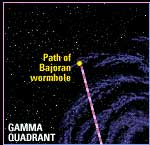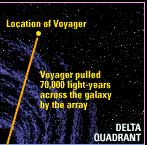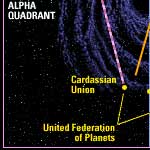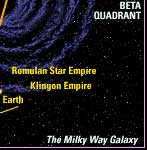Milky Way Galaxy

Milky Way (TOS-01)
The Milky Way was a spiral galaxy approximately 100 thousand light years across, divided into four quadrants, designated by the Greek letters Alpha, Beta, Gamma, and Delta, and were arbitrarily divided using Earth as a reference point. As a result, Earth, and the Sol Sector, fell in the Alpha Quadrant, while the Vulcan and Andorian Sectors fell in the Beta Quadrant. The Gamma and Delta Quadrants remained largely unexplored by the early 25th century, though knowledge of those regions was greatly increased thanks to the Bajoran wormhole and the U.S.S. Voyager NCC-74656, respectively.[3] The galaxy was surrounded by a nearly-impenetrable energy field, dubbed the Galactic Barrier, with unpredictable neurogenic properties.[1, 3] Likewise, the core of the galaxy is surrounded by a distinct but related field, dubbed the Great Barrier.[2, 3]
The local group included two very large spiral galaxies—the Milky Way and Andromeda—and several dozen smaller, mostly irregular galaxies that were clustered around these two giants. The Large and Small Magellanic Clouds were satellite galaxies of the Milky Way, and SagDEG was a dwarf galaxy in the process of colliding with the Milky Way. Globular star clusters populated the galaxy’s halo, and were concentrated near the galactic core. There were also “tramp” globular clusters located between the galaxies in intergalactic space.[3]
References
- 1. “Where No Man Has Gone Before.” Star Trek, Episode 1. Television. 22 September 1966.
- 2. Star Trek V: The Final Frontier. Film. 9 June 1989.
- 3. “Star Trek: Star Charts.” Star Trek (Uncategorized). Book. October 2002.
Leave a Reply
Categories
- Animated Series (60)
- Articles (28)
- Books (447)
- Cast & Crew (79)
- Comics (22)
- DS9 (328)
- Early Voyages (125)
- Education (5)
- Enterprise (373)
- Excelsior (36)
- Food (19)
- Games (223)
- Klingon (70)
- Library (1,543)
- Logs (593)
- Lost Era (55)
- Medicine (18)
- Merrimac (1)
- Mirror (35)
- Miscellaneous (13)
- New Frontier (54)
- Next Generation (635)
- Original Series (681)
- Personnel (436)
- Places (369)
- Politics (12)
- Recreation (10)
- SCE (41)
- Science (1)
- Shatnerverse (9)
- Ships (455)
- Site Updates (98)
- Starfleet Academy (86)
- Stargazer (42)
- STO (61)
- Technology (45)
- Titan (59)
- To Boldly Go (1)
- TV/Film (214)
- Uncategorized (4)
- Vanguard (76)
- Voyager (236)
- Weapons (27)
- Xenology (54)



